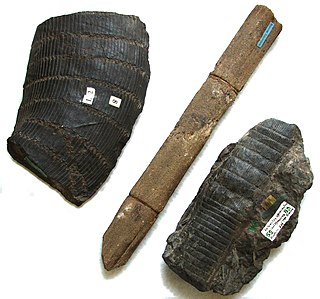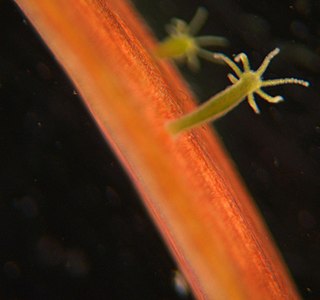
A gametophyte is one of the two alternating phases in the life cycle of plants and algae. It is a haploid multicellular organism that develops from a haploid spore that has one set of chromosomes. The gametophyte is the sexual phase in the life cycle of plants and algae. It develops sex organs that produce gametes, haploid sex cells that participate in fertilization to form a diploid zygote which has a double set of chromosomes. Cell division of the zygote results in a new diploid multicellular organism, the second stage in the life cycle known as the sporophyte. The sporophyte can produce haploid spores by meiosis.

Ploidy is the number of complete sets of chromosomes in a cell, and hence the number of possible alleles for autosomal and pseudoautosomal genes.

Reproduction is the biological process by which new individual organisms – "offspring" – are produced from their "parents". Reproduction is a fundamental feature of all known life; each individual organism exists as the result of reproduction. There are two forms of reproduction: asexual and sexual.

Organisms of many species are specialized into male and female varieties, each known as a sex. Sexual reproduction involves the combining and mixing of genetic traits: specialized cells known as gametes combine to form offspring that inherit traits from each parent. The gametes produced by an organism define its sex: males produce small gametes while females produce large gametes. Individual organisms which produce both male and female gametes are termed hermaphroditic. Gametes can be identical in form and function, but, in many cases, an asymmetry has evolved such that two different types of gametes (heterogametes) exist.

Tubers are enlarged structures in some plant species used as storage organs for nutrients. They are used for the plant's perennation, to provide energy and nutrients for regrowth during the next growing season, and as a means of asexual reproduction. Stem tubers form thickened rhizomes or stolons. Common plant species with stem tubers include potato and yam. Some sources also treat modified lateral roots under the definition; these are encountered in sweet potato, cassava, and dahlia.

Organs are groups of tissues with similar functions. Plant and animal life relies on many organs that coexist in organ systems.
A storage organ is a part of a plant specifically modified for storage of energy (generally in the form of carbohydrates) or water. Storage organs often grow underground, where they are better protected from attack by herbivores. Plants that have an underground storage organ are called geophytes in the Raunkiær plant life-form classification system. Storage organs often, but not always, act as perennating organs which enable plants to survive adverse conditions.

Calamites is a genus of extinct arborescent (tree-like) horsetails to which the modern horsetails are closely related. Unlike their herbaceous modern cousins, these plants were medium-sized trees, growing to heights of more than 30 meters (100 feet). They were components of the understories of coal swamps of the Carboniferous Period.
Dioecy is a characteristic of a species, meaning that it has distinct male and female individual organisms. Dioecious reproduction is biparental reproduction. Dioecy is one method that excludes self-fertilization and promotes allogamy (outcrossing), and thus tends to reduce the expression of recessive deleterious mutations present in a population. Flowering plants have several other methods of excluding self-fertilization, called self-incompatibility.

Alpine plants are plants that grow in an alpine climate, which occurs at high elevation and above the tree line. There are many different plant species and taxon that grow as a plant community in these alpine tundra. These include perennial grasses, sedges, forbs, cushion plants, mosses, and lichens. Alpine plants are adapted to the harsh conditions of the alpine environment, which include low temperatures, dryness, ultraviolet radiation, and a short growing season.

A male (♂) organism is the physiological sex that produces sperm. Each spermatozoon can fuse with a larger female gamete, or ovum, in the process of fertilization. A male cannot reproduce sexually without access to at least one ovum from a female, but some organisms can reproduce both sexually and asexually. Most male mammals, including male humans, have a Y chromosome, which codes for the production of larger amounts of testosterone to develop male reproductive organs. Not all species share a common sex-determination system. In most animals, including humans, sex is determined genetically, but in some species it can be determined due to social, environmental, or other factors. For example, Cymothoa exigua changes sex depending on the number of females present in the vicinity.
Fragmentation in multicellular organisms is a form of asexual reproduction in which an organism is split into fragments. Each of these fragments develop into matured, fully grown individuals that are identical to their parents.

A cryptogam is a plant that reproduces by spores, without flowers or seeds. "Cryptogamae" means "hidden reproduction", referring to the fact that no seed is produced, thus cryptogams represent the non-seed bearing plants. Other names, such as "thallophytes", "lower plants", and "spore plants" are also occasionally used. As a group, Cryptogamae are the opposite of the Phanerogamae or Spermatophyta, the seed plants. The best-known groups of cryptogams are algae, lichens, mosses and ferns, but it also includes non-photosynthetic organisms traditionally classified as plants, such as fungi, slime molds, and bacteria.The classification is now deprecated in Linnaean taxonomy.
In biology, a propagule is any material that functions in propagating an organism to the next stage in its life cycle, such as by dispersal. The propagule is usually distinct in form from the parent organism. Propagules are produced by plants, fungi, and bacteria.

Plant reproduction is the production of new offspring in plants, which can be accomplished by sexual or asexual reproduction. Sexual reproduction produces offspring by the fusion of gametes, resulting in offspring genetically different from the parent or parents. Asexual reproduction produces new individuals without the fusion of gametes, genetically identical to the parent plants and each other, except when mutations occur. In seed plants, the offspring can be packaged in a protective seed, which is used as an agent of dispersal.
Underground stems are modified plant structures that derive from stem tissue but exist under the soil surface. They function as storage tissues for food and nutrients, propagation of new clones, and perennation. Types include bulbs, corms, rhizomes, stolon, spindle - shaped and tubers

Sessility is the biological property of an organism describing its lack of a means of self-locomotion. Absent natural motility sessile organisms are normally immobile. This is distinct from the botanical meaning of sessility, which refers to an organism or biological structure attached directly by its base without a stalk.
The reproductive system or genital system is a system of sex organs within an organism which work together for the purpose of sexual reproduction. Many non-living substances such as fluids, hormones, and pheromones are also important accessories to the reproductive system. Unlike most organ systems, the sexes of differentiated species often have significant differences. These differences allow for a combination of genetic material between two individuals, which allows for the possibility of greater genetic fitness of the offspring.

Female (♀) is the sex of an organism, or a part of an organism, that produces non-mobile ova. Barring rare medical conditions, most female mammals, including female humans, have two X chromosomes. Female characteristics vary between different species with some species containing more well defined female characteristics. Both genetics and environment shape the prenatal development of a female.
Botany is a natural science concerned with the study of plants. The main branches of botany are commonly divided into three groups: core topics, concerned with the study of the fundamental natural phenomena and processes of plant life, the classification and description of plant diversity; applied topics which study the ways in which plants may be used for economic benefit in horticulture, agriculture and forestry; and organismic topics which focus on plant groups such as algae, mosses or flowering plants.

















